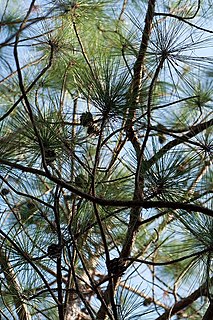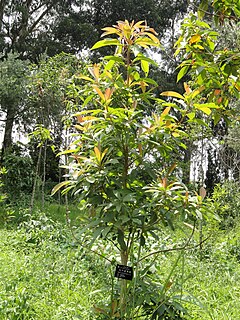
Dianchi Lake, also known as Lake Dian and Kunming Lake, is a large lake located on the Yunnan-Guizhou Plateau close to Kunming, Yunnan, China. Its nickname is the "Sparkling Pearl Embedded in a Highland" and it was the model for the Kunming Lake in the Summer Palace in Beijing. Its name is the source of Yunnan's Chinese abbreviation 滇.

Heteropanax is a genus of flowering plants in the family Araliaceae. They are native to Asia.

Pinus yunnanensis, the Yunnan pine, is a species of conifer in the family Pinaceae. It is found in the Chinese provinces of Yunnan, Sichuan, Guizhou, and Guangxi.
Craigia yunnanensis is a species of flowering plant in the family Malvaceae sensu lato or Tiliaceae. It is found in China and Vietnam. It is threatened by habitat loss.
Glyphoglossus yunnanensis, also known as Yunnan squat frog or Yunnan small narrow-mouthed frog, is a species of frog in the family Microhylidae. It is found in southern China and northern Vietnam; it probably occurs in adjacent Laos and in eastern Myanmar.
Nanorana yunnanensis, commonly known as Yunnan paa frog, Yunnan spiny frog, Bourret's paa frog or Bourret's frog, is a species of frog in the family Dicroglossidae. It is found in southwestern China, Vietnam, Myanmar, northern Thailand, and likely in the intervening Laos. Its natural habitats are small and large streams in montane forests, scrub vegetation and grasslands, and it has also been found in ditches. It is threatened primarily by collection for human consumption, but also by habitat loss caused by agricultural development and infrastructure development.

The Yunnan box turtle is a species of turtle in the family Geoemydidae. It is believed to be endemic to Yunnan, China and was suspected to be extinct since the early 20th century; the last verified specimen was collected in 1940.
Aristolochia yunnanensis is a species of plant in the family Aristolochiaceae. It is endemic to China.
Bulleyia is a genus of plants in the family Orchidaceae. It is either epiphytic or lithophitic, growing on tree branches or on rocks on steep hillsides. The genus is monotypic and represented only by Bulleyia yunnanensis, native to the Himalayas of Assam, Bhutan, eastern India and Yunnan.
Heteropanax nitentifolius is a species of plant in the family Araliaceae. It is endemic to China.
Mangifera austro-yunnanensis is a species of plant in the family Anacardiaceae. It is endemic to China.
Melodinus fusiformis is a species of plant in the family Apocynaceae. It is native to China, Indochina, and the Island of Luzon in the Philippines.
Myristica yunnanensis is a species of plant in the family Myristicaceae. It is found in southern Yunnan, China, northern Thailand, and in Thanh Hóa Province, Vietnam. It is a large, evergreen tree, up to 30 m (98 ft) tall.

Nyssa yunnanensis is a species of tree in the Nyssa genus. It is a dioecious tree reaching 25–30 m (82–98 ft) in height. This flowering canopy tree inhabits mountainous tropical bogs and marshes.
Orophea yunnanensis is a species of plant in the Annonaceae family. It is endemic to China.
Panisea yunnanensis is a species of plant in the family Orchidaceae. It is native to China and to Vietnam.
Pellacalyx yunnanensis is a species of plant in the Rhizophoraceae family. It is endemic to China.

Corylus yunnanensis, the Yunnan hazel, is a species of hazelnut found in western China. It is a small tree or shrub. The flowers have triangular shaped petals. The round nuts which are encased in a very tough oval shaped shell and can be consumed by humans. The plant is not commercially grown for the nuts, rather they are sometimes used as ornamental plants. They are located in Western Guizhou, Hubei, South Western and Western Sichuan, and Western Yunnan.
Trimeresurus yunnanensis, commonly known as the Yunnan bamboo pitviper, is a venomous pitviper species endemic to China.
The Yunnan bush rat is a species of rodent from the family Muridae. It has just recently been released from synonymy with the Manipur bush rat, and so there is very little information about it. It was recognized as a separate species due to its much larger body size in comparison to the Manipur bush rat, relatively shorter tail, pure white underparts as opposed to gray, significantly shorter diastema, and shorter palate in relation to its skull. It is located only in Yunnan province of the People's Republic of China, where it known only from Tongbiguan Nature Reserve in Ruili City.






